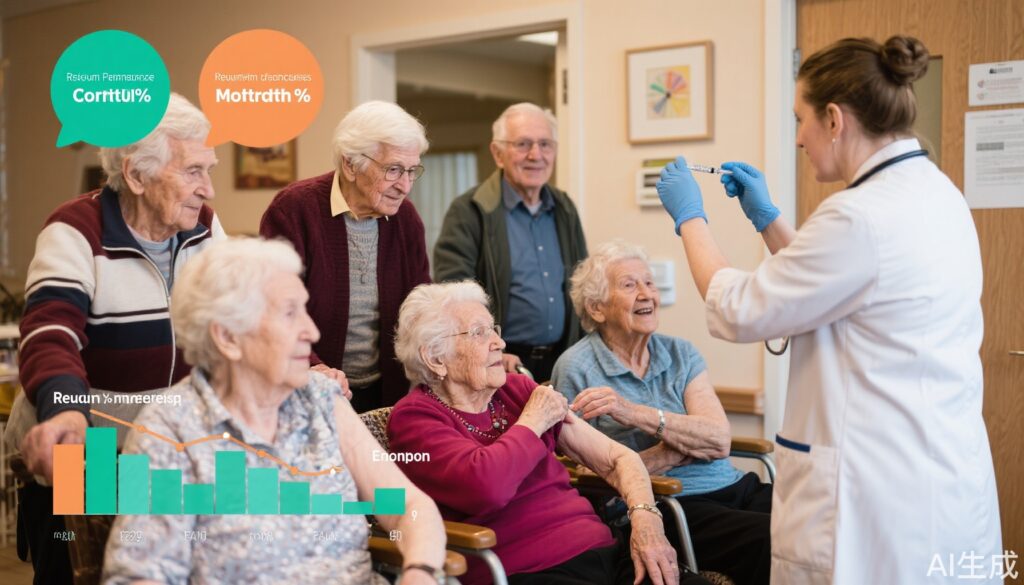Highlights
– New residents of older adult care homes in England face a markedly higher risk of invasive pneumococcal disease (IPD) and death compared to their community-dwelling peers.
– Targeted pneumococcal vaccination (PPV23 or PCV20) for these new residents offers far greater prevention of IPD cases and deaths per dose than the current age-based strategy.
– The 20-valent pneumococcal conjugate vaccine (PCV20) is projected to have a larger impact than PPV23, with lower numbers needed to vaccinate (NNV) for both disease and mortality prevention.
– A policy shift to prioritize care home entrants for pneumococcal immunisation would require only a modest increase in doses but yield greater population-level benefit.
Study Background and Disease Burden
Invasive pneumococcal disease (IPD) remains a significant cause of morbidity and mortality among older adults, especially those living in communal settings. In England, the incidence of IPD escalates rapidly with age, and care home residents experience even higher rates due to increased frailty, comorbidities, and close living quarters. Current UK policy offers the 23-valent pneumococcal polysaccharide vaccine (PPV23) to all adults at age 65, while the recently licensed 20-valent pneumococcal conjugate vaccine (PCV20) provides broader serotype coverage and potentially superior protection.
Despite the national immunisation programme, outbreaks and severe outcomes persist among care home residents, highlighting an unmet need for improved preventive strategies. The study by Abdullahi et al., published in The Lancet Healthy Longevity, quantifies the potential impact of specifically vaccinating new care home residents with PPV23 or PCV20, compared to the current age-based approach.
Study Design
This was a national observational surveillance study leveraging two key data sources: the UK Health Security Agency’s IPD surveillance for adults aged ≥65 years during the 2022-23 epidemiological year, and the Care Quality Commission’s registry of care homes for older adults. The study population included new entrants to residential and nursing homes for those aged 65 and older in England.
Key outcome metrics included the number needed to vaccinate (NNV) to prevent one case of vaccine-type IPD and one death, comparing:
– All adults at age 65 receiving PPV23 or PCV20 (current policy)
– New care home residents receiving an additional dose of PPV23 or PCV20
Assumptions included vaccine effectiveness (VE) of 36% against PPV23-type IPD and 75% for PCV20-type IPD, with both vaccines presumed to reduce IPD-related mortality by 18%.
Key Findings
Among 10,629,867 adults aged ≥65 in England (2022-23), 2,574 IPD cases were reported; 69.4% were attributed to PPV23 serotypes and 60.8% to PCV20 serotypes. Of 603,109 adults aged exactly 65, standard PPV23 vaccination was projected to prevent 163 (36%) of 452 PPV23-type IPD cases (NNV 3,700) and 31 (47%) of 66 PPV23-type IPD-related deaths over 5 years (NNV 19,455).
In contrast, vaccinating 121,587 new care home residents with PPV23 could prevent 177 (36%) of 492 lifetime cases (NNV 687) and 111 (48%) of 233 deaths (NNV 1,095)—a 5–6-fold improvement in efficiency compared to the age-based approach.
For PCV20, age-based vaccination of all 65-year-olds could prevent 303 (75%) of 404 cases (NNV 1,990) and 43 (80%) of 54 PCV20-type IPD deaths (NNV 14,026). However, targeting PCV20 to new care home residents would prevent 317 (75%) of 422 cases (NNV 384) and 157 (80%) of 197 deaths (NNV 774), further lowering the NNV needed to achieve meaningful benefits.
These data indicate that focusing vaccination efforts on new care home residents, who represent only about 20% more doses than the current universal 65-year-old approach, could yield a substantially greater reduction in disease burden and mortality. PCV20, in particular, offers superior protection and efficiency over PPV23 in this high-risk group.
Expert Commentary
The findings align with long-standing concerns that care home residents are especially vulnerable to IPD, often experiencing more severe outcomes than their community-dwelling peers. This study provides robust, population-level evidence that a targeted vaccination strategy would dramatically improve public health outcomes at a modest cost in additional vaccine doses.
Current UK guidelines recommend single-dose PPV23 at age 65, but do not routinely offer additional pneumococcal immunisation upon entry to residential care. The new data suggest that updating policy to include PCV20 or additional PPV23 for new care home residents would be both clinically and economically justified. International guidelines, such as those from the US CDC, already recommend broader use of conjugate vaccines in older adults and those at increased risk.
Limitations include the assumptions regarding vaccine effectiveness, which may vary based on emerging serotype prevalence and individual immunosenescence. Real-world effectiveness of PCV20 in the oldest and most frail populations remains under evaluation. Nonetheless, the magnitude of benefit per dose supports the case for immediate policy review.
Conclusion
Targeted pneumococcal vaccination for new residents entering older adult care homes in England—particularly with PCV20—could markedly reduce the incidence of IPD and associated mortality. This strategy is more efficient and impactful than the current age-based approach, requiring only a modest increase in vaccine use for a disproportionate gain in public health benefit. Policymakers should consider revising immunisation guidance to prioritise this high-risk population, and further research should continue to monitor vaccine effectiveness and cost-effectiveness in real-world settings.
References
1. Abdullahi F, Patel T, Stoker K, Carey C, Andrews N, Ramsay M, Cassell J, Ladhani SN. Pneumococcal vaccination for new residents entering older adult care homes in England: national observational surveillance study. Lancet Healthy Longev. 2025 Jun;6(6):100726. doi: 10.1016/j.lanhl.2025.100726. Epub 2025 Jul 1. PMID: 40614750.
2. Public Health England. Pneumococcal: the green book, chapter 25. Updated 2023. https://www.gov.uk/government/publications/pneumococcal-the-green-book-chapter-25
3. Centers for Disease Control and Prevention. Use of 20-valent pneumococcal conjugate vaccine in U.S. adults. MMWR Morb Mortal Wkly Rep. 2022;71(4):123–130.
4. Vila-Córcoles A, et al. Efficacy and effectiveness of pneumococcal vaccination in older adults: a systematic review and meta-analysis. PLoS One. 2021;16(3):e0248677.



